
by Claire Davis | Jan 13, 2022
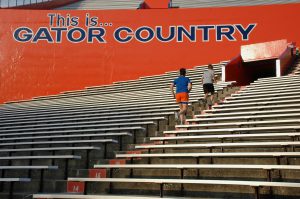
Being more active is one of the top New Year’s Resolutions.
Photo credit: UF/IFAS Photo: Sally Lanigan.
Well, it’s that time of year again. January 1st has finally rolled around and I still have not completed last year’s New Year’s Resolution. If you’re like me, your resolution is to lose weight in 2022. Maybe you have chosen to quit smoking, exercise more, or try to be more positive. Maybe these resolutions sound familiar to you because they were last year’s resolutions, too!
You don’t have a New Year’s Resolution yet? Below is a list of some of the most common New Year’s Resolutions that could help you spark an idea!
-

Exercising with others can help you stay on track to reach your wellness goals.
Photo credit: UF/IFAS Photo: Josh Wickham.
Exercise more
- Lose weight
- Get organized
- Learn a new skill or hobby
- Save more money
- Quit the use of tobacco
- Quit the use of alcohol
- Spend more time with family and friends
- Travel more
- Read more
So, how do you ensure that you are going to stick to your resolution? Below are a few New Year’s Resolution tips to help us create long-lasting change:
- Dream big! The bigger, the better. Do you want to learn to run a marathon? Do you want to fit back into those jeans you wore in high school? Being ambitious will help inspire others around you to cheer you on toward those goals.
- Break that big dream down into smaller pieces. Running 26 miles seems daunting, but when you start with just walking 1 mile, you will soon gain the confidence to push for more. Choosing to reach for healthier snacks, such as carrots or celery instead of potato chips, is a small change that can affect your diet. You do not have to deprive yourself of foods you enjoy to lose weight. You just have to focus on portion control. Small steps will move you forward to your ultimate goal.
- Commit yourself to your goals! Write them down, post your goals on social media, or verbally promise to others that you are going to do it. Hold yourself accountable to what you are trying to do. Sometimes, making a public announcement will encourage others to join you on your journey. They can push you to be the best version of yourself, while also holding you accountable.
- Give yourself a pat on the back! “Rome wasn’t built in a day.” Well, neither will you accomplish your end goal in one day. Typically, our new year’s resolutions take time, sometimes a very long time. Encourage yourself to keep going by acknowledging what you do accomplish!
- Learn from your past. I am not perfect, you are not perfect, no one is perfect! We all stumble at times, but it is how we recover that will set us up for success or failure. If you “fall off the healthy-eating train” one evening, don’t beat yourself up or give up. Tomorrow is a new day, and you can resolve to recover from your mistakes to get back on track.
- Support! I have mentioned inspiring others already, but you need support, too. Accept help from those who care about you to help you achieve your goals. Consider joining a support group, such as a workout class at the gym or a group of co-workers to quit smoking. These individuals share your struggles and want to see you succeed, which makes the challenge less intimidating!
- The 3 R’s: Reflect, Replace, and Reinforce. The 3 R’s can help you make a long-term change. Reflect on your current situation, i.e. eating habits. Replace those unhealthy habits with healthier ones. Reinforce these changes in your daily life.
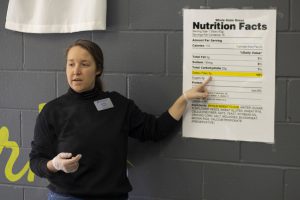
Use the Nutrition Facts label to make healthy food choices.
Photo credit: UF/IFAS.
According to the American Psychological Association, “By making your resolutions realistic, there is a greater chance that you will keep them throughout the year, incorporating healthy behavior into your every day life.” The dreaded New Year’s Resolution does not have to seem unattainable. If you plan to make a New Year’s Resolution this year, limit the number of resolutions you choose so that you can focus on them. By creating new habits and making small changes, you can do anything you put your mind to!
Sources:
https://www.health.harvard.edu/staying-healthy/seven-steps-for-making-your-new-years-resolutions-stick
https://www.apa.org/topics/behavioral-health/new-year-resolutions
https://www.dhs.gov/employee-resources/blog/2020/01/07/new-years-resolutions

by Amy Mullins, PhD, RDN | Nov 23, 2021
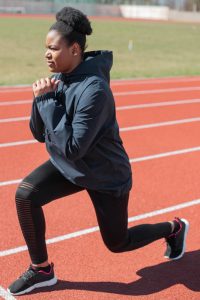 Take care of your bones today for better quality of life tomorrow!
Take care of your bones today for better quality of life tomorrow!
According to the National Institutes of Health, about one in every two Americans over the age of 50 may already have or be at risk of developing osteoporosis. (1) Osteoporosis is a disease where, over time, bone quality and strength decline, making bones more likely to fracture and break. Fractures can develop not only as a result of a slip or fall but also from everyday sneezing or coughing. If your doctor diagnoses you with osteoporosis, the best course of action for slowing its progression may be prescription medication. However, nutrition and exercise can help provide a good foundation to prevent or delay disease development. (1)
Know Your Risks
While all risks are not completely understood, there is a genetic factor linked to osteoporosis – mainly, if poor bone mineral density runs in the family. In addition to genetic factors, poor nutrition, smoking, excessive alcohol, and a lack of exercise can all increase your risk of developing osteoporosis. It is important to talk to your doctor to discuss your level of risk and prevention measures. (1)
Build More Bone
Although they may not seem like it, bones are a living tissue and go through times of building and breakdown during the life cycle. Bones grow the most during childhood, but they also change and become stronger as an adult by doing exercises like weightlifting or running. (1) Similar to a savings account or retirement fund, the more you build when you are young, the more you can afford to spend as you age. Current recommendations to support strong bones include muscle strengthening exercises at least two times per week. These exercises require your muscles to do more work than doing just day-to-day activities. Additionally, strength training exercises should be done to the point where it would be difficult to perform one or two more repetitions. Examples include lifting weights, working with resistance bands, and doing body weight exercises such as push-ups, pull-ups, and planks. Additionally, climbing stairs, and carrying heavy loads (such as groceries and heavy gardening) also count when done frequently.(2)
Support Your Bones
In addition to exercise, nutrition plays a large role in promoting healthy bones. The two most important nutrients for bone health are calcium and vitamin D. Calcium is what gives bones their strength but is also involved in many other processes in the body. If you do not regularly consume enough calcium, your body takes it from your bones. (3) If this happens for long enough, your bones will become weakened and begin to develop osteoporosis. Vitamin D is important for the absorption of calcium. Not having enough vitamin D can impact your bones, even if you get enough calcium from your diet. (4)
| Life-stage group |
Calcium (mg/day) |
Vitamin D (IU/day) |
| Infants 0-6 months |
200 |
400 |
| Infants 6-12 months |
260 |
400 |
| 1-3 years old |
700 |
600 |
| 4-8 years old |
1,000 |
600 |
| 9-13 years old |
1,300 |
600 |
| 14-18 years old |
1,300 |
600 |
| 19-30 years old |
1,000 |
600 |
| 31-50 years old |
1,000 |
600 |
| 51–70-year-old males |
1,000 |
600 |
| 51–70-year-old females |
1,200 |
600 |
| > 70 years old |
1,200 |
600 |
| 14-18 years old, pregnant/lactating |
1,300 |
600 |
| 19-50 years old, pregnant/lactating |
1,000 |
600 |
Recommended Calcium and Vitamin D Intakes (5) Definitions: mg = milligrams; IU = International Units
Bone Strengthening Foods
There are a variety of food sources that provide calcium and vitamin D. Calcium can be found in dairy products, green vegetables, and calcium-fortified foods. Examples of calcium-containing dairy products include cheese, yogurt, and reduced-fat milk. Other calcium-fortified foods include breads, orange juice, cereals, and tofu. When it comes to vitamin D in your diet, be sure to include fatty fish such as tuna and salmon. There are smaller amounts of vitamin D found in cheese, mushrooms, and beef liver. Similar to calcium, there are many vitamin D-fortified foods available. Some examples are cereals, orange juice, milk, and milk products. Check out the two tables below for calcium and vitamin D food sources. (5)
Calcium Content of Selected Foods
| Food |
Serving size |
Milligram (mg) per serving |
% DV |
| Sardines, canned in oil |
3 oz |
324 |
32% |
| Cheddar cheese, shredded |
1 ½ oz |
306 |
31% |
| Nonfat milk |
8 oz |
302 |
30% |
| Yogurt, reduced fat, no solids |
8 oz |
300 |
30% |
| 2% milk (reduced fat) |
8 fl oz |
297 |
30% |
| Whole milk |
8 fl oz |
291 |
29% |
| Cottage cheese, 1% milk fat |
2 cups, unpacked |
276 |
28% |
| Mozzarella, part skim |
1 ½ oz |
275 |
28% |
| Tofu firm, with calcium |
½ cup |
204 |
20% |
| Orange juice, calcium fortified |
6 fl oz |
200-260 |
20-26% |
| Tofu soft, with calcium |
½ cup |
138 |
14% |
| Frozen yogurt, vanilla, soft serve |
½ cup |
103 |
10% |
| Ready-to-eat cereal, calcium fortified |
1 cup |
100-1000 |
10-100% |
| Turnip greens, boiled |
½ cup |
99 |
10% |
| Kale, raw |
1 cup |
90 |
9% |
| Vanilla ice cream |
½ cup |
85 |
8.5% |
| Soy beverage, calcium fortified |
8 fl oz |
80-500 |
8-50% |
| Flour tortilla |
1, 6” diameter |
37 |
4% |
| Sour cream, reduced fat, cultured |
2 Tbsp |
32 |
3% |
Adapted from Office of the Surgeon General (US). Bone Health and Osteoporosis: A Report of the Surgeon General. (7)
Vitamin D Content of Selected Foods
| Food |
Serving size |
Micrograms (mcg) per serving |
International Units (IU) per serving |
Percent DV |
| Cod liver oil |
1 Tbsp |
34 |
1,360 |
170 |
| Rainbow trout, cooked |
3 oz |
16.2 |
645 |
81 |
| Salmon (sockeye), cooked |
3 oz |
14.2 |
570 |
71 |
| White mushrooms, raw, exposed to UV light |
½ cup |
9.2 |
366 |
46 |
| 2% milk, vitamin D fortified |
1 cup |
2.9 |
120 |
15 |
| Soy, almond, & oat milk, vitamin D fortified |
1 cup |
2.5-3.6 |
100-144 |
13-18 |
| Ready-to-eat cereal, fortified with 10% DV vitamin D |
1 serving |
2.0 |
80 |
10 |
| Sardines (Atlantic), canned in oil, drained |
2 |
1.2 |
46 |
6 |
| Egg, scrambled |
1 large |
1.1 |
44 |
6 |
| Beef liver, braised |
3 oz |
1.0 |
42 |
5 |
| Tuna fish (light), canned in water, drained |
3 oz |
1.0 |
40 |
5 |
| Cheddar cheese |
1.5 oz |
0.4 |
17 |
2 |
| Portabella mushrooms, raw, diced |
½ cup |
0.1 |
4 |
1 |
| Chicken breast, roasted |
3 oz |
0.1 |
4 |
1 |
| Ground beef, 90% lean, broiled |
3 oz |
0 |
1.7 |
0 |
| Broccoli, raw, chopped |
½ cup |
0 |
0 |
0 |
Adapted from Vitamin D – Fact sheet for health professionals (8)
Stay Safe and Healthy as You Age
Osteoporosis can be a serious and life changing diagnosis. However, adopting healthy habits like limiting smoking and excessive alcohol consumption can decrease your risk. Consuming enough calcium and vitamin D each day and getting regular muscle building exercise at least twice a week can also help protect your bones. Women over the age of 65, or anyone diagnosed as “at risk,” should be regularly screened for osteoporosis by a doctor during their yearly physical health exam. (6,7,8)
Making healthy lifestyle choices from a young age can help prevent or delay osteoporosis, but once you’re diagnosed, the best course of action for slowing its progression may be prescription medication. Consult your doctor before beginning a new exercise program or for interactions with medications.
References
- “Osteoporosis Overview.” National Institutes of Health, U.S. Department of Health and Human Services, https://www.bones.nih.gov/health-info/bone/osteoporosis/overview.
- S. Department of Health and Human Services. Physical Activity Guidelines for Americans, 2nd edition. Washington, DC: U.S. Department of Health and Human Services; 2018.
- “Osteoporosis.” Edited by Susan Randall, Osteoporosis | Office on Women’s Health, National Institute of Arthritis and Musculoskeletal and Skin Diseases, 20 May 2019, https://www.womenshealth.gov/a-z-topics/osteoporosis.
- “Office of Dietary Supplements – Vitamin D.” NIH Office of Dietary Supplements, U.S. Department of Health and Human Services, 22 Mar. 2021, https://ods.od.nih.gov/factsheets/vitaminD-HealthProfessional/
- S. Department of Agriculture and U.S. Department of Health and Human Services. Dietary Guidelines for Americans, 2020-2025. 9th Edition. December 2020. Available at DietaryGuidelines.gov
- Palmer S. Bone Health and Diet. Today’s Dietitian. 2013;15(2):44.
- Office of the Surgeon General (US). Bone health and osteoporosis: A report of the surgeon general. Rockville (MD): Office of the Surgeon General (US); 2004. Table 7-2, Selected Food Sources of Calcium. Available from: https://www.ncbi.nlm.nih.gov/books/NBK45523/table/ch7.t2/
- Vitamin D – Fact sheet for health professionals. NIH Office of Dietary Supplements. https://ods.od.nih.gov/factsheets/VitaminD-HealthProfessional/#h3. Published August 17, 2021. Accessed November 11, 2021.
Guest contributors: Andrew Treble and Lexi Fraino are master’s students and Dietetic Interns from Florida State University’s Department of Nutrition & Integrative Physiology.

by Amy Mullins, PhD, RDN | Aug 27, 2021
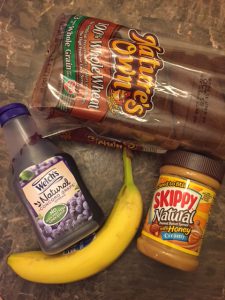
Healthy snacks fuel the athlete! Photo credit: Amy Mullins
When it comes to your kids, you’d do anything to help them succeed… in the classroom, in their relationships, in life. So, why not on the basketball court, soccer field, swimming pool, or whichever sport they’ve fallen in love with? They may have the best equipment, participate in extra training lessons, and put in 110% during every practice and event. But, is this enough? Is there something missing?
It’s no secret that your child is growing. In order to function in their sport, improve performance, and promote recovery, kids need food to help support the increased energy requirements. This ultimately means more planning and more groceries!
Follow these guidelines to fuel your superstar during the week, before the game/event, and after the game/event.
Pre-Game Meal/Snack
Eat a good-sized meal at least three hours before the event. This gives the tummy time to process all the food to prepare it as fuel. Have a light balanced meal with some carbs and fats. These will sustain you throughout your exercise! Carbs and fats are both great fuel sources, and the fats digest slower to help keep you feeling full. Pick foods that digest well to avoid any nausea or upset stomach. Don’t forget to drink some water to start off hydrated!
- Breakfast Ideas: fruit, lightly sautéed potatoes, scrambled eggs, or toast with nut butter or smashed avocado
- Lunch Ideas: turkey or ham sandwich (avoid fatty cheeses and condiments), peanut butter and jelly, fruit, pretzels, or cereal
- Snack 30 minutes before the event: peanut butter crackers, granola bars, fruit snacks, or goldfish crackers
During Practice and Games
For exercise lasting less than an hour, sip on some water to stay hydrated. For exercise lasting longer than an hour, a sports drink like Gatorade or Powerade will help replenish lost carbohydrates and electrolytes. For longer lasting activities or day trips, bring along some easy to eat snacks with lots of carbs, and some fats and proteins. Peanut butter and jelly sandwiches and granola bars are great options!
Post-Game Snack
After exercise, it’s important to recover, refuel, and re-hydrate. Protein will help our muscles recover while carbohydrates will help refuel for the next activity. Drink plenty of fluids to rehydrate! Good choices for quick, easy snacks include chocolate milk, peanut butter crackers, cheese sticks, bananas, apple slices with peanut butter, or smoothies with or without protein.
Dinner Plate After Practice and Games
- Grains/Carbs: Should take up roughly 35% of the plate
- Lean Protein: Should take up roughly 25% of the plate
- Fruits and Veggies: Should take up roughly 40% of the plate
- Hydration: Focus on replenishing lost electrolytes and fluid loss
Components of a well-balanced meal include:
- Meat & poultry – great protein sources for recovery. Pair it with a carb!
- Whole grains, fruit, pasta, rice, potatoes – great carb sources to complement your protein. These will help replace the energy you burned during exercise.
- Water, milk, and fruits will help replenish fluids lost during exercise.
Eating right not only on game day but throughout the week will do wonders for your child’s athletic performance. Not only that, it will set them up to be successful and healthy adults in the future!
Guest contributors: Patrick Burns and E. Jane Watts, Dietetic Interns from Florida State University’s Department of Food, Nutrition, and Exercise Sciences
The use of trade names in this post is solely for the purpose of providing specific information. It is not a guarantee, warranty, or endorsement of the product.
References:
Academy of Nutrition & Dietetics. Ellis, E. (2020). Hydrate Right. https://www.eatright.org/fitness/sports-and-performance/hydrate-right/hydrate-right
American Dietetic Association, Dietitians of Canada, American College of Sports Medicine,
Rodriguez, N. R., Di Marco, N. M., & Langley, S. (2009). American College of Sports Medicine position stand. Nutrition and athletic performance. Medicine and science in sports and exercise, 41(3), 709–731.
https://performancepartner.gatorade.com
https://www.eatright.org/fitness/sports-and-performance/tips-for-athletes/gameday-nutrition-tips-for-young-athletes

by Melanie Taylor | Jul 9, 2021

Some house plants are very easy to keep alive, even if you are a first-time gardener. Photo source: Melanie Taylor
As July begins, one mental health topic we repeatedly hear or read about is how stress is negatively affecting so many Americans right now. In these unprecedented times, many people are reaching out for guidance from their doctors, therapists, friends, and family. Depending on how your stress levels are affecting you, there are numerous suggestions ranging from exercise to therapy to medication and the list goes on. There may be one solution right at your fingertips that can help you begin to find a little peace of mind starting today. Gardening…. Let’s DIG IN!
Gardening does not have to be growing a large vegetable garden in the backyard. It can be planting flowers and plants in your landscape, maintaining potted plants on your front porch and deck, or growing houseplants inside your home. One easy way to start if you have never been a gardener is by growing herbs inside or out. Many people find gardening helps them escape to a place of peace as they dig in the soil and watch their plants and flowers grow and prosper.
This idea is not new. Horticulture is the art and science of growing plants. Horticultural therapy is the practice of engaging people in plant or gardening activities to improve their bodies, minds, and spirits. Research confirms that healthful benefits accrue when people connect with nature and plants by viewing and/or interacting with them.

Enjoy socializing with friends and neighbors in the garden. Photo source: Julie McConnell
Horticultural therapy has been around for a very long time. In the 1600’s, the poor often worked in gardens to pay for their medical care. Physicians quickly noticed these patients recovered faster and had better overall health than patients who did not work in the garden. Today, many hospitals, long-term care facilities, rehabilitation centers, prisons, schools, social-service facilities, and community centers use people-plant interactions as a form of treatment for persons with physical or mental disabilities. Horticultural therapy may include meeting with a therapist specializing in this area or trying something on your own or with family, friends, or a local gardening group.
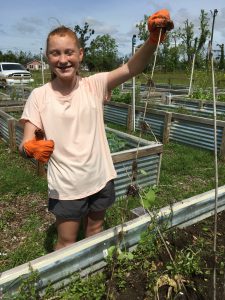
Saturday mornings are family time at the local community garden plot. Photo source: Julie McConnell
Some benefits you may receive from gardening include:
- Physical: Provides exercise at various levels. (Easy, medium, and strenuous levels – it all depends on what you decide to create.)
- Emotional: Promotes and satisfies your creative side, increases your feelings of confidence and self-esteem, promotes a new interest and enthusiasm for it, and even relieves tension.
- Physiological: May help lower blood pressure and heart rate, decrease cortisol levels, and ultimately relieve stress.
Even if you think you do not have a “green thumb,” you should try gardening on any level and see if it will be a healthy mode of stress release for you. Happy Gardening!
Source:
UF/IFAS Extension EDIS Document ENH970: Horticultural Therapy, Elizabeth Diehl and Sydney Park Brown.

by Terri Keith | Oct 11, 2020
According to the Centers for Disease Control and Prevention (CDC), falls by older adults aged 65 and up can often result in serious injuries, decreased mobility and a loss of independence. They are common and can happen at a high cost, both financially and in terms of health and lifestyle for the person who falls. Statistics from the CDC show “each year, 3 million older people are treated in emergency departments for fall injuries” and the death rate from falls in the U.S. has been on the rise—30% from 2007 to 2016.
While many falls don’t cause injuries, some do and can leave the person with bruises, sprains, broken bones or head injuries. Even if a person falls without suffering an injury, that fall may lead to a fear of falling. Both the injuries and the fear of falling can lead a person to limit their daily activities. By being less active, the person increases their risk of falling again.
It’s not all bad news though. Many falls are preventable and several of the steps you can take for yourself or a loved one are low or no cost. Start by looking for risk factors. These are conditions that increase the chances of a fall happening. Here are some to be aware of:
- Taking more than 2 medications daily.
- Having a hearing and/or vision impairment.
- Experiencing dizziness when getting up, changing positions, or walking.
- Having trouble getting in and out of a chair, walking, picking up objects from the floor or reaching overhead without holding on to something.
- Having throw rugs, cluttered walkways, uneven surfaces or slippery floors.
- Navigating stairs without rails.
- Having poor lighting conditions.
- Wearing shoes with high heels or slippery soles.
- Having fallen in the past year or being afraid of falling.
Many of these can be corrected or managed. One of the key steps to preventing falls is talking with your doctor and pharmacist. They can help with evaluating your risk and advise you on specific things you can do, especially in terms of problems with hearing, vision or medications. Staying active or following exercise routines can help with balance and strength. Here is a link to some beginner level exercises to start with if you’re not already exercising.
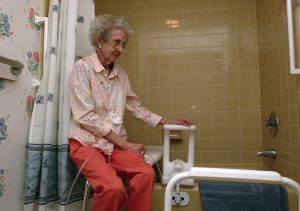
An elderly persons bathroom can be made safer by adding items that will help them maneuver easier. Photo Credit: UF/IFAS Marisol Amador
Do a check of your home to see if you have any of the risk factors above and correct them. Here are some other steps you can take at home:

Keeping a lamp beside the bed means you don’t have to walk through the dark at night to get to the light switch. Photo credit: Terri Keith, UF/IFAS Extension
- Lower shelves 3 inches for easier access; adjust closet rods to keep clothes within reach.
- Use a reacher or grabber for items that are too high. NEVER use a chair as a step stool.
- Install or add more lighting in your home especially near walkways, stairs and entrances.
- Keep a lamp and flashlight by your bed and night lights where needed.
- Install or secure handrails on both sides of the stairs and use them every time.
- Make sure walkways are clear and uncluttered. Remove or secure throw rugs, cords and hoses out of the way.
- Use textured surfaces for patios, driveways and stairs. Mark any changes in floor level with reflective tape.
- Be aware of your pet’s location when you stand or walk so they don’t trip you.
- Install and use grab bars to help with getting in and out of the bath safely.
- Use a rubber mat in your bathtub or shower.
- Install a handheld showerhead and use it with a bath bench or chair when showering.
If a fall does happen, even if there were no injuries, it’s a good idea to let your doctor know about it the next time you see them. It can help alert them to new medical problems or a need to review your prescriptions. Taking these steps can help reduce the risk of a fall and stop the cycle of falling from being repeated.
Resources:
Centers for Disease Control and Prevention, Home and Recreational Safety: https://www.cdc.gov/homeandrecreationalsafety/falls/index.html and https://www.cdc.gov/homeandrecreationalsafety/falls/adultfalls.html
University of Florida, IFAS: https://edis.ifas.ufl.edu/fy734 and https://edis.ifas.ufl.edu/fy733
National Institute on Aging: https://www.nia.nih.gov/health/prevent-falls-and-fractures and https://www.nia.nih.gov/health/fall-proofing-your-home

by Julie McMillian | May 11, 2020
What does your morning and evening routine consist of? Now that we are adjusting to our new normal of staying at home and social distancing, many routines are different than before. How about starting a routine of walking 30 minutes or an hour each day? There are so many positive benefits to even just adding 15 minutes to your schedule and most everyone, including children, can do it.
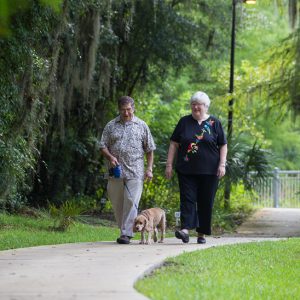
Walking is a great form of exercise that nearly everyone can do. (Photo source: Lyon Duong, UF/IFAS)
Walking improves your mood and reduces stress and anxiety. Who doesn’t need that kind of positive influence in their life right now? If you walk in the morning, it will provide you with energy for the rest of the day and walking in the evening helps you to sleep better at night. Taking a few extra steps each day can add some time to clear your head and add to your energy level while creating a positive mindset for other activities.
One of the other benefits of walking is burning calories. Burning calories may lead to weight loss. It seems that almost every American is always looking for a way to improve the fitness of their body. By exercising during a walk, you build stronger muscles, ligaments and tendons. Physically, walking can reduce your hips, tighten abdominal muscles, strengthen your arms, and tone your legs. Walking gives you a chance to improve balance, coordination and flexibility. Your feet can help to reduce the load on other joints while keeping knee joints healthy and lowering the risk of blood clots. Walking makes your heart stronger and reduces risk of stroke. A research team from the University of Michigan Medical School says that people who are in the 50s-60s age bracket who exercise regularly are 35 percent less likely to die in the next eight years than those who do not. Therefore, some walking each day could help you lead to a longer life.
Now that we have so many reasons to take a stroll each day, we must make sure to walk correctly to avoid injury. It is important to move freely and naturally while swinging your arms to avoid back problems. Keep your shoulder back with your head held high and eyes forward. Position your feet straight and push off with your hind leg to engage your hips. Watch for traffic if you are walking by a highway and of course practice social distancing for now. Maybe later ask a friend to join for a social aspect and to have accountability to someone. Keep a log to track progress. The CDC recommends 150 minutes of moderate activity per week to be considered active adults. That should add up to about 7,000 to 8,000 steps a day but if you can get 10,000, go for it! It is a great time to get into this daily routine and doesn’t require any special equipment or memberships.
So what are you waiting for? There is no better time to start stepping.
For more information on healthy living or other extension related topics, contact your local UF/IFAS Extension Agent.
Additional Resources:
Healthstyle: A Self-Test (UF/IFAS Extension)
Healthy Living: Beating Barriers to Physical Activity (UF/IFAS Extension)
Improving Savings, Health, and Happiness by Modifying How the Family Operates the Home (UF/IFAS Extension)
Walking: Your Steps to Health (Harvard Health)
UF/IFAS Extension is an Equal Opportunity Institution.

















